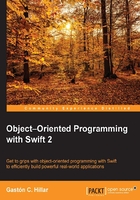
Conventions
In this book, you will find a number of text styles that distinguish between different kinds of information. Here are some examples of these styles and an explanation of their meaning.
Code words in text, database table names, folder names, filenames, file extensions, pathnames, dummy URLs, user input, and Twitter handles are shown as follows: "We can assign 20 to regularHexagon1.lengthOfSide and 50 to regularHexagon2.lengthOfSide."
A block of code is set as follows:
let degCUnitFromStr = HKUnit(fromString: "degC") let degFUnitFromStr = HKUnit(fromString: "degF")
When we wish to draw your attention to a particular part of a code block, the relevant lines or items are set in bold:
Animal created Mammal created DomesticMammal created Dog created TerrierDog created SmoothFoxTerrier created I am 7 years old. I am 14 years old. I am 21 years old. I am 4 years old. I am 5 years old.
New terms and important words are shown in bold. Words that you see on the screen, for example, in menus or dialog boxes, appear in the text like this: "Start Xcode, navigate to File | New | Playground…."
Note
Warnings or important notes appear in a box like this.
Tip
Tips and tricks appear like this.